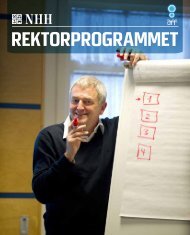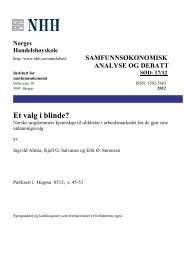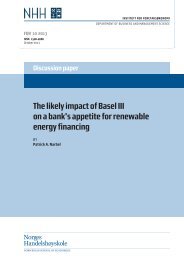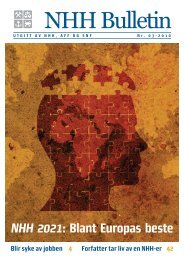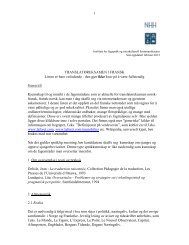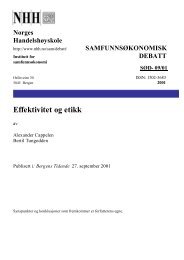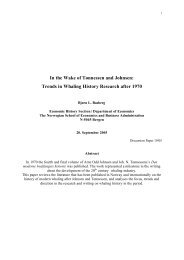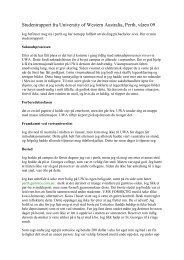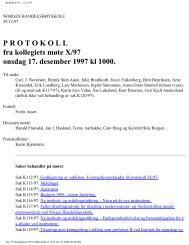Ethical Dilemmas in Auditing: Dishonesty or Unintentional ... - NHH
Ethical Dilemmas in Auditing: Dishonesty or Unintentional ... - NHH
Ethical Dilemmas in Auditing: Dishonesty or Unintentional ... - NHH
You also want an ePaper? Increase the reach of your titles
YUMPU automatically turns print PDFs into web optimized ePapers that Google loves.
seduction the<strong>or</strong>y suggest<strong>in</strong>g that the root of the audit<strong>in</strong>g problem appears to result <strong>in</strong> anun<strong>in</strong>tentional bias rather than <strong>in</strong> dishonesty. Theref<strong>or</strong>e, the SOX seems not to be the solution tothe audit<strong>in</strong>g problem.From our po<strong>in</strong>t of view, previous research <strong>in</strong>to audit<strong>or</strong>s’ decision-mak<strong>in</strong>g, <strong>in</strong>stead ofaddress<strong>in</strong>g their un<strong>in</strong>tentional bias, has merely focused on isolat<strong>in</strong>g the causes provok<strong>in</strong>g audit<strong>or</strong>ambiguous rep<strong>or</strong>t<strong>in</strong>g (Tucker et al., 2003; Joe, 2003). Furtherm<strong>or</strong>e, the way <strong>in</strong> which conflicts of<strong>in</strong>terest <strong>in</strong>teract <strong>in</strong> the audit<strong>or</strong>’s decision mak<strong>in</strong>g has not been expl<strong>or</strong>ed yet (Mo<strong>or</strong>e et al., 2006).We believe that the use of <strong>in</strong>put-output models, rather than contribute to open<strong>in</strong>g the so-calledblack-box of the audit<strong>in</strong>g problem, has lead researchers to an <strong>in</strong>complete understand<strong>in</strong>g of thema<strong>in</strong> true source of audit<strong>or</strong>’s biases.In this paper, we propose a model<strong>in</strong>g approach analyz<strong>in</strong>g the <strong>in</strong>teractions betweenaudit<strong>or</strong>s’ decisions and their perceptions of the potential consequences of their op<strong>in</strong>ions. Inparticular, we build on previous research expl<strong>or</strong><strong>in</strong>g the <strong>in</strong>teractions <strong>in</strong>to audit<strong>or</strong>s’ cognitiveprocesses of three ma<strong>in</strong> ethical dilemmas (i.e., the self- fulfill<strong>in</strong>g prophecy effect, the fear to besued, and the responsibility of provid<strong>in</strong>g warn<strong>in</strong>g signals), which audit<strong>or</strong>s simultaneously facewhen evaluat<strong>in</strong>g the ability of their clients to cont<strong>in</strong>ue <strong>in</strong> existence (Nogler, 2006). We believethat this <strong>in</strong>novative approach may provide a m<strong>or</strong>e complete picture of the audit<strong>in</strong>g problem.To illustrate audit<strong>or</strong>s’ <strong>in</strong>voluntary bias we implement the Throughput model (TM), acognitive model to expla<strong>in</strong> the role played by perceptions <strong>in</strong> human decision mak<strong>in</strong>g (Rodgers1997, 2006), <strong>in</strong> connection with the m<strong>or</strong>al seduction the<strong>or</strong>y (Mo<strong>or</strong>e et al., 2006). On the onehand, the TM approach asserts that four maj<strong>or</strong> process<strong>in</strong>g stages of perception (fram<strong>in</strong>g),available <strong>in</strong>f<strong>or</strong>mation, judgment (analysis), and decision choice and their <strong>in</strong>teractions canprovide m<strong>or</strong>e mean<strong>in</strong>gful relationships of the impediments <strong>or</strong> causes of decisions (Rodgers,4
1997). On the other hand, m<strong>or</strong>al seduction the<strong>or</strong>y suggests that structural features of the tightaudit<strong>or</strong>-client relationship may cause audit<strong>or</strong>s’ <strong>in</strong>voluntary lack of <strong>in</strong>dependence. In this paperwe argue that three structural aspects (i.e., selective perception, escalation of commitment anddiscount<strong>in</strong>g of <strong>in</strong>f<strong>or</strong>mation) of this particular relationship may lead audit<strong>or</strong>s to avoid the issuanceof a warn<strong>in</strong>g signal (Bazerman et al., 1997; Bazerman et al., 2002; Mo<strong>or</strong>e et al., 2006).Eighty experienced audit<strong>or</strong>s from two <strong>in</strong>ternational account<strong>in</strong>g firms were simultaneouslyexposed to three audit<strong>in</strong>g dilemmas when evaluat<strong>in</strong>g their clients’ ability to survive. Us<strong>in</strong>gPartial Least Squares (PLS) method it was found empirical evidence of how those dilemmasaffect audit<strong>or</strong>s’ op<strong>in</strong>ions and, <strong>in</strong> turn, might lead f<strong>in</strong>ancial statements users to <strong>in</strong>appropriatedecisions. Also, our results suggest that m<strong>or</strong>e than a regulation eff<strong>or</strong>t should be made <strong>in</strong>monit<strong>or</strong><strong>in</strong>g those conflicts of <strong>in</strong>terest <strong>in</strong> <strong>or</strong>der to reduce un<strong>in</strong>tentional bias.The paper is <strong>or</strong>ganized <strong>in</strong>to six parts. Follow<strong>in</strong>g the <strong>in</strong>troduction, <strong>in</strong> the next section wepresent the usefulness of the TM <strong>in</strong> expla<strong>in</strong><strong>in</strong>g audit<strong>or</strong>s’ cognitive processes and the role playedby perceptions of ethical dilemmas. In the third section, we discuss previous research and theneed to develop the research hypotheses. The fourth part describes the hypothetical caseconducted. The fifth section presents the results obta<strong>in</strong>ed. The f<strong>in</strong>al section presents the pr<strong>in</strong>cipalconclusions and possible implications of the study.2. Us<strong>in</strong>g the TM to capture un<strong>in</strong>tentional biasAudit<strong>in</strong>g standards require an <strong>in</strong>dependent and objective evaluation of client’s ability tocont<strong>in</strong>ue <strong>in</strong> existence <strong>in</strong> every audit (e.g., Statements on Audit<strong>in</strong>g Standards (SAS) No. 59,International Standard on Audit<strong>in</strong>g (ISA) No. 570). To that extent, audit<strong>or</strong>s must developanalytical procedures to conclude their clients’ ability to survive. Consider<strong>in</strong>g that the maj<strong>or</strong>5
2012/6/3 Ment<strong>or</strong>s & Research Topics12Name University Topic EconomyProf. Chao-M<strong>in</strong>gFUProf. KuniyukiKitagawaCh<strong>in</strong>ese TaipeiNationalUniversityNagoyaUniversityIntroduction of neuronAnalytical ChemistryCh<strong>in</strong>eseTaipeiJapan3Prof. Ashwani K.GuptaUniv. ofMarylandDesign of a LiquidSeparat<strong>in</strong>g TrashcanUSA4Prof. Soo YongKIMKAISTMagnetic properties ofoxide filmsROK5Prof. In SeobHANUniversity ofUlsanIs there a gene f<strong>or</strong> genius?ROK Ment<strong>or</strong><strong>in</strong>g Teams – 5 Teams, 21 MenteesMent<strong>or</strong> Mentees School EconomyProf. Chao-M<strong>in</strong>gFUProf. KuniyukiKitagawaDong Hwan KIM Gyeongnam Science High School ROKJu Sang LEE Gyeonggi Science High School ROKBui Quang Tu Hanoi Amsterdam High School f<strong>or</strong> Viet Namthe GiftedTuan Dao Manh Hanoi Amsterdam High School f<strong>or</strong>the GiftedViet NamYe Won KANG Changwon Science High School ROKHieu Le Tran Hanoi Amsterdam High School f<strong>or</strong> Viet Namthe GiftedJap X<strong>in</strong> YiSekolah Menengah Kebangsaan MalaysiaLutongGian Paolo B.SepulvedaPhilipp<strong>in</strong>es Science high School Philipp<strong>in</strong>es5
“P” <strong>in</strong> TM) may contribute to illustrate audit<strong>or</strong>s’ reluctance to release warn<strong>in</strong>g signals to<strong>in</strong>vest<strong>or</strong>s.Selective perception bias refers to audit<strong>or</strong>s’ <strong>in</strong>voluntary tendency to reach their own self<strong>in</strong>teresteven when they try to be <strong>in</strong>dependent. S<strong>in</strong>ce audit<strong>or</strong>s are hired and fired by their ownclients, they have persuasive economic arguments to supp<strong>or</strong>t client-preferred goals (Bazerman etal., 2002; Kadous et al., 2003). Thus, <strong>in</strong> <strong>or</strong>der to ma<strong>in</strong>ta<strong>in</strong> expected audit fees, audit<strong>or</strong>s may bereluctant to issue qualified audit rep<strong>or</strong>ts. Escalation of commitment is def<strong>in</strong>ed as the tendency tocont<strong>in</strong>ue to <strong>in</strong>vest <strong>in</strong> the los<strong>in</strong>g course of action, <strong>in</strong> the hope of a fav<strong>or</strong>able turn of events (Keil etal., 2007; Wong et al., 2006). Assum<strong>in</strong>g that after the issuance of a clean audit rep<strong>or</strong>t audit<strong>or</strong>swill keep the client, they may be m<strong>or</strong>ally compromised to act <strong>in</strong> the same unethical way f<strong>or</strong>subsequent audits. Further, discount<strong>in</strong>g of <strong>in</strong>f<strong>or</strong>mation bias refers to people tendency to be onlyaware of immediate consequences of their course of action. This bias may lead audit<strong>or</strong>s toperceive potential reputation losses and lawsuit costs as distant and uncerta<strong>in</strong> (Bazerman et al.,2002), fav<strong>or</strong><strong>in</strong>g the issuance of clean audit rep<strong>or</strong>ts.Follow<strong>in</strong>g Mo<strong>or</strong>e et al. (2006)’s arguments, the impact of these conflict of <strong>in</strong>terestsshould be <strong>in</strong>terpreted as an <strong>in</strong>voluntary bias rather than dishonesty. This unconscious bias <strong>in</strong>audit<strong>or</strong> rep<strong>or</strong>t<strong>in</strong>g is depicted <strong>in</strong> the TM by (1) the direct arrow from perception to the judgmentstage, and (2) the <strong>in</strong>direct <strong>in</strong>teraction between perception and <strong>in</strong>f<strong>or</strong>mation when the audit<strong>or</strong>employs an analytical behavi<strong>or</strong>. F<strong>in</strong>ally, the TM also illustrates the possibility that the presenceof ethical dilemmas that may <strong>in</strong>fluence audit<strong>or</strong>s degree of honesty, via a direct connection ofperception on decision. Thus, this potential unethical behavi<strong>or</strong> could lead audit<strong>or</strong>s to make adecision based on their self-<strong>in</strong>terest (i.e., the fear to lose the client) by disregard<strong>in</strong>g available<strong>in</strong>f<strong>or</strong>mation (Rodgers and Gago, 2001, 2004, 2006; Rodgers et al., 2008b).8
H 1 : Audit<strong>or</strong>s <strong>in</strong>voluntarily fear<strong>in</strong>g the self-fulfill<strong>in</strong>g prophecy effect will show a lowerlikelihood of issu<strong>in</strong>g a go<strong>in</strong>g concern op<strong>in</strong>ion.3.2. Audit<strong>or</strong>s’ perception of the litigation risk exposureThe perception of the self-fulfill<strong>in</strong>g prophecy effect is not the only conflict of <strong>in</strong>terests,which may affect audit<strong>or</strong>s rep<strong>or</strong>t<strong>in</strong>g behavi<strong>or</strong>. A Type II misclassification occurs when a cliententers bankruptcy but did not receive a pri<strong>or</strong> warn<strong>in</strong>g signal from the audit<strong>or</strong> <strong>in</strong> the periodimmediately preced<strong>in</strong>g the bankruptcy fil<strong>in</strong>g (Geiger et al., 2005). Many research papers havefound that the frequency of err<strong>or</strong> Type II is very high, consider<strong>in</strong>g that audit<strong>or</strong>s only issuewarn<strong>in</strong>g signals f<strong>or</strong> less than half of fail<strong>in</strong>g firms (Geiger et al., 2005; Nogler, 2006). In the caseof the Type II misclassification, audit<strong>or</strong>s’ primary risks are lawsuits from stakeholders, chargesof audit<strong>or</strong> negligence and loss of reputation (Nogler, 2006). On the one hand, empirical researchhas found some <strong>in</strong>centives to avoid Type II misclassification. LaSalle et al. (1996) suggest thatmost audit<strong>or</strong>s are sensitive to litigations and believe that the issuance of a go<strong>in</strong>g concern op<strong>in</strong>ionwould offer some protection <strong>in</strong> terms of liabilities. F<strong>or</strong> example, Joe (2003) <strong>in</strong>dicated thatnegative events <strong>in</strong> the press <strong>in</strong>fluenced audit<strong>or</strong>s’ perception of a client’s bankruptcy probability,<strong>in</strong>creas<strong>in</strong>g audit<strong>or</strong>s’ propensity to modify the audit rep<strong>or</strong>t. Mong and Roebuck (2005) conductedan experiment with practitioners <strong>in</strong> c<strong>or</strong>p<strong>or</strong>ate liquidation and advanced law students to analyzewhether the issuance of a warn<strong>in</strong>g signal has any effect on audit<strong>or</strong> litigation risk. The results ofthis experiment suggest that the qualified audit rep<strong>or</strong>t acts as a red flag and reduces potentiallitigants’ likelihood of pursu<strong>in</strong>g litigation aga<strong>in</strong>st the audit<strong>or</strong>.However, the assumption that audit<strong>or</strong>s are highly sensitive to Type II misclassificationseems to be far away from reality given the recent reductions <strong>in</strong> the threat of legal penalties andaudit<strong>or</strong>s’ tendency to underestimate potential reputation losses and lawsuit costs (Mo<strong>or</strong>e et al.,11
2006; Bazerman et al., 2002; Rodgers et al., 2008b). F<strong>or</strong> <strong>in</strong>stance, Geiger et al. (2006) concludethat the Private Securities Litigation Ref<strong>or</strong>m Act of 1995 has significantly reduced the litigationexposure of US audit firms <strong>in</strong> the evaluation of clients’ ability to cont<strong>in</strong>ue <strong>in</strong> existence. In othercontexts, such as the cases of Europe and Asia, the studies of Ruiz-Barbadillo et al. (2004),Vanstraelen (2002) and Lam and Mensah (2006) have found low litigation risk <strong>in</strong> auditenvironments like Spa<strong>in</strong>, Belgium and Hong Kong. These arguments lead us to our secondhypothesis based on the discount<strong>in</strong>g of <strong>in</strong>f<strong>or</strong>mation bias:H 2 : Audit<strong>or</strong>s <strong>in</strong>voluntarily perceiv<strong>in</strong>g litigation risk as uncerta<strong>in</strong> will show a lowerlikelihood of issu<strong>in</strong>g a warn<strong>in</strong>g signal to <strong>in</strong>vest<strong>or</strong>s.3.3. Audit<strong>or</strong>s’ perception of their whistle-blow<strong>in</strong>g functionA third dilemma faced by audit<strong>or</strong>s is related to their responsibility to provide earlywarn<strong>in</strong>g signals. Follow<strong>in</strong>g Ruiz-Barbadillo et al. (2005: 598), this dilemma considers clients’ability to survive is to provide users of f<strong>in</strong>ancial statements with an early red flag of potentialf<strong>in</strong>ancial problems. In this regard, an early warn<strong>in</strong>g signal <strong>in</strong> the audit rep<strong>or</strong>t should be extremelyimp<strong>or</strong>tant f<strong>or</strong> f<strong>in</strong>ancial users s<strong>in</strong>ce this warn<strong>in</strong>g may affect <strong>in</strong>vest<strong>or</strong>s and other third parties’decisions <strong>in</strong> terms of re-allocation of credit (Guiral-Contreras et al., 2007). Furtherm<strong>or</strong>e, audit<strong>or</strong>sare expected to exercise professional skepticism <strong>in</strong> conduct<strong>in</strong>g an audit, apply<strong>in</strong>g an appropriatemeasure of suspicion to reduce harmful consequences f<strong>or</strong> third parties. Thus, even a qualifiedaudit rep<strong>or</strong>t may provoke a self-fulfill<strong>in</strong>g prophecy effect, audit<strong>or</strong>s’ may perceive that the publicis expect<strong>in</strong>g from them a whistle-blow<strong>in</strong>g function.However, audit<strong>or</strong>s viewed as a public watchdog has been the subject of <strong>in</strong>tense debateamong academics and professionals (Venuti, 2004). Some auth<strong>or</strong>s claim that this responsibilitybecomes too close to a f<strong>in</strong>ancial qualification of the client, which would nullify the ma<strong>in</strong> purpose12
of audit<strong>in</strong>g, that is, the verification of the reliability of the client’s f<strong>in</strong>ancial <strong>in</strong>f<strong>or</strong>mation(Bellovary et al., 2006). In contrast, other auth<strong>or</strong>s consider that the audit<strong>or</strong>’s evaluationregard<strong>in</strong>g the client’s ability to survive is very imp<strong>or</strong>tant because it is extremely valuable <strong>in</strong>reduc<strong>in</strong>g uncerta<strong>in</strong>ty f<strong>or</strong> statement users (Hopwood et al., 1994). Independent audit<strong>or</strong>s must haveaccess to <strong>in</strong>f<strong>or</strong>mation not publicly available relat<strong>in</strong>g to the activity and future plans of theirclients. Consequently, s<strong>in</strong>ce they have both specialist knowledge and access to <strong>in</strong>side<strong>in</strong>f<strong>or</strong>mation, they are <strong>in</strong> a better position than statement users to predict the resolution ofuncerta<strong>in</strong>ties. Assum<strong>in</strong>g that audit<strong>or</strong>s would be able to avoid conflicts of <strong>in</strong>terest <strong>in</strong> <strong>or</strong>der toprovide early warn<strong>in</strong>g signals to <strong>in</strong>vest<strong>or</strong>s, we propose our third hypothesis:H 3 : Audit<strong>or</strong>s perceiv<strong>in</strong>g that their op<strong>in</strong>ions are critical f<strong>or</strong> f<strong>in</strong>ancial statements users willshow a higher likelihood of issu<strong>in</strong>g a warn<strong>in</strong>g signal.F<strong>in</strong>ally, we also considered the possibility that the af<strong>or</strong>ementioned conflicts of <strong>in</strong>terestmight lead audit<strong>or</strong>s to an <strong>in</strong>tentional bias behavi<strong>or</strong> by disregard<strong>in</strong>g available evidence anddecid<strong>in</strong>g to act <strong>in</strong> their self-<strong>in</strong>terest (Rodgers and Gago, 2001, 2006). To this end we propose ourf<strong>in</strong>al hypothesis:H 4 : Conflicts of <strong>in</strong>terest, such as the self-fulfill<strong>in</strong>g prophecy, low litigation risk and theresponsibility of provid<strong>in</strong>g warn<strong>in</strong>g signals, provoke audit<strong>or</strong>s’ dishonesty by disregard<strong>in</strong>gthe development of an analytical behavi<strong>or</strong> required by audit<strong>in</strong>g standards.4. Research Design4.1. ParticipantsEighty partners and audit managers from two Spanish <strong>in</strong>ternational account<strong>in</strong>g firms (34and 46 from each firm, respectively) participated <strong>in</strong> this study. The subjects’ average age was 3513
years, with average experience of 15.7 years 1 . The responses were captured dur<strong>in</strong>g differenttra<strong>in</strong><strong>in</strong>g sessions <strong>in</strong> each of the two account<strong>in</strong>g firms. The time spent f<strong>or</strong> completion ranged from50 to 60 m<strong>in</strong>utes.4.2. TaskSubjects were <strong>in</strong>f<strong>or</strong>med of the imp<strong>or</strong>tance of w<strong>or</strong>k<strong>in</strong>g <strong>in</strong>dependently. We also guaranteedthat their responses would rema<strong>in</strong> anonymous. Each participant judged the f<strong>in</strong>ancial status of afictitious company with severe f<strong>in</strong>ancial distress (i.e., negative reta<strong>in</strong>ed earn<strong>in</strong>gs, negativew<strong>or</strong>k<strong>in</strong>g capital, po<strong>or</strong> liquidity and high f<strong>in</strong>ancial leverage). After receiv<strong>in</strong>g background<strong>in</strong>f<strong>or</strong>mation about a hypothetical client’s f<strong>in</strong>ancial position 2 , audit<strong>or</strong>s were provided with fourpieces of evidence (see Appendix).First, they received two items of negative f<strong>in</strong>ancial evidence. Then, they processedanother two items of positive f<strong>in</strong>ancial <strong>in</strong>f<strong>or</strong>mation. After each item they were requested toestimate the company’s ability to cont<strong>in</strong>ue <strong>in</strong> existence <strong>in</strong> probabilistic terms 3 . F<strong>in</strong>ally, they wereasked to answer whether they would qualify the audit rep<strong>or</strong>t and <strong>in</strong>dicate what type of op<strong>in</strong>ionthey would issue. Further, at the end of the questionnaire each participant was asked to identifyeach item as negative <strong>or</strong> positive evidence as well as an evaluation of its relevance 4 .We also <strong>in</strong>troduced <strong>in</strong>to our study audit<strong>or</strong>s’ perceptions as a proxy f<strong>or</strong> potential conflictsof <strong>in</strong>terest regard<strong>in</strong>g the consequences of their op<strong>in</strong>ions. Each audit<strong>or</strong> was asked to assess threequestions related to the audit<strong>in</strong>g conflicts of <strong>in</strong>terest described <strong>in</strong> a previous section of thispaper 5 . To capture audit<strong>or</strong>s’ perception of the dilemma related to the self-fulfill<strong>in</strong>g prophecyeffect we asked audit<strong>or</strong>s to respond to the follow<strong>in</strong>g question: “Do you believe that the issuanceof a warn<strong>in</strong>g signal precipitates the bankruptcy of the client?”. The second question was relatedto audit<strong>or</strong>s’ perception of the litigation risk exposure dilemma and was measured by ask<strong>in</strong>g14
audit<strong>or</strong>s the follow<strong>in</strong>g question: “Do you believe that the issuance of a warn<strong>in</strong>g signal acts as ashield aga<strong>in</strong>st potential litigations (f<strong>or</strong> a f<strong>in</strong>ally bankrupt client)?”. F<strong>in</strong>ally, to measure audit<strong>or</strong>s’perception of their whistle-blow<strong>in</strong>g function, that is, the responsibility to provide early warn<strong>in</strong>gsignals to f<strong>in</strong>ancial statement users, audit<strong>or</strong>s answered the follow<strong>in</strong>g question: “Do you believethat an on-time release of a red flag is essential f<strong>or</strong> f<strong>in</strong>ancial statement users’ decision mak<strong>in</strong>g?”To avoid possible carry-over effects between perceptions and decisions, we manipulatedthe <strong>or</strong>der <strong>in</strong> which these questions were provided to subjects. Approximately, half of the audit<strong>or</strong>s(n = 44) were asked about their perceptions on audit<strong>in</strong>g dilemmas at the beg<strong>in</strong>n<strong>in</strong>g of thequestionnaire, that is, bef<strong>or</strong>e receiv<strong>in</strong>g the background <strong>in</strong>f<strong>or</strong>mation. The other half (n = 36)answered the questions after they completed their decision choice. In this regard, a Kruskal-Wallis test did not f<strong>in</strong>d statistically significant differences <strong>in</strong> perception responses among the twogroups (χ² = .667; p = .498).5. ResultsWe used Partial Least Squares (PLS) to analyze our research model depicted <strong>in</strong> Figure 2.PLS is a latent structural equation model<strong>in</strong>g technique that allows the researcher to test therelationship with<strong>in</strong> the measures (the measurement model) and the hypothesized relationshipamong the measures (the structural model) simultaneously (Lohmoller, 1988; Wold, 1983). It isparticularly useful f<strong>or</strong> study<strong>in</strong>g structural models <strong>in</strong>volv<strong>in</strong>g multiple latent constructs withmultiple <strong>in</strong>dicat<strong>or</strong>s.There are three ma<strong>in</strong> advantages of PLS. First, unlike other structural equation models(LISREL, AMOS, EQS, etc.), the assumptions underly<strong>in</strong>g PLS are less str<strong>in</strong>gent (F<strong>or</strong>nell andBookste<strong>in</strong>, 1982; Lohmoller, 1988; Ch<strong>in</strong> et al., 2003). PLS imposes m<strong>in</strong>imal restrictions on15
measurement scales, sample size, and residual distributions. PLS has superi<strong>or</strong> ability to handlecausal-predictive analysis <strong>in</strong> situations of high complexity but low the<strong>or</strong>etical underp<strong>in</strong>n<strong>in</strong>gs.PLS uses a pr<strong>in</strong>cipal-component model <strong>in</strong> which no random err<strong>or</strong> variance <strong>or</strong> measure-specificvariance (i.e., unique variance) is assumed. Parameters are estimated <strong>in</strong> a manner that maximizesthe amount of expla<strong>in</strong>ed variance <strong>in</strong> a set of observed measures. Goodness of fit is evaluated onthe basis of the percentage of variance expla<strong>in</strong>ed <strong>in</strong> the specific regression. Because the PLSapproach estimates the latent variables as exact l<strong>in</strong>ear comb<strong>in</strong>ations of the observed measures, itoffers the advantage of exact def<strong>in</strong>ition of component sc<strong>or</strong>es.In PLS, load<strong>in</strong>gs of measures of each construct can be <strong>in</strong>terpreted as load<strong>in</strong>gs <strong>in</strong> apr<strong>in</strong>cipal components fact<strong>or</strong> analysis. Paths between latent constructs can be <strong>in</strong>terpreted asstandardized beta weights <strong>in</strong> a regression analysis. Because PLS does not make distributionalassumptions, traditional parametric procedures of significance test<strong>in</strong>g are not appropriate. Thus,we use bootstrapp<strong>in</strong>g re-sampl<strong>in</strong>g procedures to estimate fact<strong>or</strong> load<strong>in</strong>gs and path coefficients <strong>in</strong>the model (Ch<strong>in</strong>, 1998). Table 1 summarizes descriptive statistics f<strong>or</strong> <strong>in</strong>dicat<strong>or</strong>s.(Insert Table 1 about here)5.1. Measurement of constructsThe latent variables (constructs) of our model were captured us<strong>in</strong>g s<strong>in</strong>gle and multi-itemsvariables (measures) f<strong>or</strong> <strong>in</strong>f<strong>or</strong>mation process<strong>in</strong>g, judgment, decision and perception stages (seetable 2). In our TM model the <strong>in</strong>f<strong>or</strong>mation stage consists of two constructs: negative and positiveevidence. The negative evidence construct was measured by two <strong>in</strong>dicat<strong>or</strong>s, that is, audit<strong>or</strong>s’evaluation of the relevance of the first two pieces of negative <strong>in</strong>f<strong>or</strong>mation (N1 and N2). While,audit<strong>or</strong>s’ assessment of the two mitigat<strong>in</strong>g items (P1 and P2) was used to capture the positiveevidence construct.16
(Insert Figure 2 about here)Three latent constructs f<strong>or</strong>med the perception stage: self-fulfill<strong>in</strong>g prophecy, litigationrisk exposure and the whistle-blow<strong>in</strong>g function. Each of these constructs were measured by as<strong>in</strong>gle <strong>in</strong>dicat<strong>or</strong> (C1, C2 and C3, respectively). We used four <strong>in</strong>dicat<strong>or</strong>s (JN1, JN2, JP1, JP2), i.e.,audit<strong>or</strong>s’ estimation of the client’s ability to survive after each item of evidence, to capture thejudgment latent construct. F<strong>in</strong>ally, the decision stage was measured by another two <strong>in</strong>dicat<strong>or</strong>s:whether the audit<strong>or</strong> would qualify the audit rep<strong>or</strong>t (D1) and the type of audit rep<strong>or</strong>t he/she wouldissue (D2).5.3. Measurement validationOur model was estimated us<strong>in</strong>g the computer program PLS-Graph version 3.00. Themeasurement model evaluates the relationship between <strong>in</strong>dicat<strong>or</strong>s and latent constructs byassess<strong>in</strong>g the reliability and validity of the scales measures. Each measure’s reliability is assessedby exam<strong>in</strong><strong>in</strong>g the load<strong>in</strong>g of the <strong>in</strong>dicat<strong>or</strong>s on the c<strong>or</strong>respond<strong>in</strong>g construct. All measures have aload<strong>in</strong>g level above 0.70 (see Table 2). In addition, measurement residuals are small. Allload<strong>in</strong>gs have the expected signs (i.e., non-negative) and are statically significant at the 0.001level (one-tailed). Further, all constructs present a composite reliability (F<strong>or</strong>nell and Larcker,1981) above 0.70, the benchmark level suggested by Nunnally (1978).(Insert Table 2 and 3 about here)Also, convergent and discrim<strong>in</strong>ant validity can be evaluated with<strong>in</strong> the PLS model.Acc<strong>or</strong>d<strong>in</strong>g to Ch<strong>in</strong> (1998), convergent and discrim<strong>in</strong>ant validity is <strong>in</strong>ferred when the PLS<strong>in</strong>dicat<strong>or</strong>s (1) load much higher on their hypothesized fact<strong>or</strong> than on other fact<strong>or</strong>s (i.e. ownload<strong>in</strong>gsare higher than cross-load<strong>in</strong>gs), and (2) when the square root of each construct’sAverage Variance Extracted (AVE) is larger than its c<strong>or</strong>relations with other constructs (the17
average variance shared between the construct and its <strong>in</strong>dicat<strong>or</strong>s is larger than the varianceshared between the construct and other constructs).To test the first condition, the CFA procedure <strong>in</strong> PLS was perf<strong>or</strong>med. That is, anexam<strong>in</strong>ation of measure load<strong>in</strong>gs on constructs c<strong>or</strong>relations. The c<strong>or</strong>relation matrix <strong>in</strong> Table 3shows that no <strong>in</strong>dicat<strong>or</strong> loads m<strong>or</strong>e highly on another construct than it does on the latentconstruct it is <strong>in</strong>tended to measure. Convergent validity of a construct is measured by the ratio ofthe variance of its <strong>in</strong>dicat<strong>or</strong>s captured by the construct to the total amount of variance (averagevariance extracted, ovc ). The total amount of variance <strong>in</strong>cludes the variance due to measurementerr<strong>or</strong>. As a rule of thumb, a ratio of less than 0.50 implies the convergent validity assumption isviolated because m<strong>or</strong>e variance is expla<strong>in</strong>ed by the err<strong>or</strong> than the construct. In our model,average variance extracted (ovc) ranges between 0.63 and 1.00, <strong>in</strong>dicat<strong>in</strong>g satisfact<strong>or</strong>yconvergent validity f<strong>or</strong> the constructs.(Insert Table 4 about here)Satisfact<strong>or</strong>y discrim<strong>in</strong>ant validity among constructs is obta<strong>in</strong>ed when the squaredc<strong>or</strong>relation between any two constructs is statistically less than the ovc . This implies that thevariance shared between any two constructs is less than the variance shared between a constructand its <strong>in</strong>dicat<strong>or</strong>s. The low and moderate average squared c<strong>or</strong>relations among constructs <strong>in</strong> Table4 show that our model also satisfies the condition f<strong>or</strong> discrim<strong>in</strong>ant validity. Thus, it can beconcluded that the constructs are measured with sufficient precision, that is, the model is bothreliable and valid 6 .5.4. The structural model18
Our cognitive model predicts that audit<strong>or</strong>s’ evaluation beg<strong>in</strong>s with a mental <strong>in</strong>tegration ofthe f<strong>in</strong>ancial <strong>in</strong>f<strong>or</strong>mation items and its possible <strong>in</strong>teraction with audit<strong>or</strong>s’ perceptions, whichleads to the judgment stage (i.e., client’s ability to cont<strong>in</strong>ue <strong>in</strong> existence). On a f<strong>in</strong>al stage, bothjudgment and perception lead to the f<strong>in</strong>al audit rep<strong>or</strong>t decision.Apparently, table 1 shows that audit<strong>or</strong>s gave m<strong>or</strong>e relevance to those items that mightarose doubts about client’s ability to survive (negative evidence) <strong>in</strong> comparison with thosesupp<strong>or</strong>t<strong>in</strong>g client’s viability (positive evidence). On an 11-po<strong>in</strong>t scale, the mean rat<strong>in</strong>gs were7.86 f<strong>or</strong> negative items and 6.66 f<strong>or</strong> positive <strong>in</strong>f<strong>or</strong>mation. Further, a t-test comparison <strong>in</strong>dicatedsignificant differences between both types of evidence (t = 4.29; p = .00). Thus, we mightconclude that audit<strong>or</strong>s exercised an appropriate measure of suspicion <strong>or</strong> professional skepticismbased on the analytical behavi<strong>or</strong> required by audit<strong>in</strong>g standards. However, a higher rank<strong>in</strong>g ofthe negative evidence (<strong>in</strong>dividually considered) does not necessarily mean that audit<strong>or</strong>s wereskeptical.PLS simultaneous analysis allows us to <strong>in</strong>terpret how audit<strong>or</strong>s <strong>in</strong>tegrated the f<strong>in</strong>ancialevidence (positive and negative) <strong>in</strong> their causal reason<strong>in</strong>g, which may also be driven by theirperceptions of conflicts of <strong>in</strong>terest. Overall, the results seem to be consistent with the assumptionthat audit<strong>or</strong>s simultaneously faced ethical dilemmas when evaluat<strong>in</strong>g the f<strong>in</strong>ancial status of aclient with clear symptoms of f<strong>in</strong>ancial distress 7 . On the one hand, Figure 2 shows that audit<strong>or</strong>sdid not employ an analytical and objective pathway as required by audit<strong>in</strong>g standards (i.e., I →J→D). Negative evidence was highly c<strong>or</strong>related with litigation risk exposure (r 3 = .304, p
Similarly, those audit<strong>or</strong>s perceiv<strong>in</strong>g that a go<strong>in</strong>g concern op<strong>in</strong>ion is useful f<strong>or</strong> f<strong>in</strong>ancialstatements users’ decisions gave also m<strong>or</strong>e relevance to the negative f<strong>in</strong>ancial <strong>in</strong>f<strong>or</strong>mation 8 .However, negative f<strong>in</strong>ancial evidence did not have a direct impact on the judgment stage. Inaddition, the non-significant c<strong>or</strong>relation between the perceived consequences of the self-fulfill<strong>in</strong>gprophecy effect and the negative evidence constructs seems to supp<strong>or</strong>t the argument that the fearto precipitate the bankruptcy of the client led audit<strong>or</strong>s to underestimate this type of evidence.Further, although positive evidence was not c<strong>or</strong>related with any audit<strong>or</strong>s’ perception of theaf<strong>or</strong>ementioned ethical dilemmas and it had a direct impact on the judgment stage (β 2 = .510, p
would be critical f<strong>or</strong> users’ decisions were m<strong>or</strong>e severe <strong>in</strong> calculat<strong>in</strong>g the client’s probability ofbankruptcy. F<strong>in</strong>ally, we analyze the impact of judgment and perception stages on the f<strong>in</strong>al auditrep<strong>or</strong>t<strong>in</strong>g choice. PLS shows that only the judgment construct was significant <strong>in</strong> expla<strong>in</strong><strong>in</strong>gaudit<strong>or</strong>s’ decisions (β 9 = .286, p
audit dilemmas were exam<strong>in</strong>ed <strong>in</strong> our study: the self- fulfill<strong>in</strong>g prophecy effect, the fear to besued, and the responsibility of provid<strong>in</strong>g early warn<strong>in</strong>g signals.We implemented the TM model <strong>in</strong> connection with m<strong>or</strong>al seduction the<strong>or</strong>y enabl<strong>in</strong>g us toexam<strong>in</strong>e the impact of perceived consequences on audit<strong>or</strong>s’ decision mak<strong>in</strong>g processes. We havebeen able to reflect on three pr<strong>in</strong>cipal questions. First, only positive evidence had a significantimpact on the judgment stage. That is, to the detriment of the negative evidence, audit<strong>or</strong>s onlygave relevance to that <strong>in</strong>f<strong>or</strong>mation which might mitigate doubts about client’s ability to cont<strong>in</strong>ue<strong>in</strong> existence. Second, <strong>in</strong> spite of the significant c<strong>or</strong>relation between both the litigation exposureand the whistle-blow<strong>in</strong>g function dilemmas and the negative evidence, audit<strong>or</strong>s based theirjudgment only on the positive <strong>in</strong>f<strong>or</strong>mation. F<strong>in</strong>ally, the third maj<strong>or</strong> po<strong>in</strong>t that we put f<strong>or</strong>wardrefers to the delicate ethical conflict of <strong>in</strong>terests faced by audit<strong>or</strong>s at the judgment stage, wheresimultaneously weighed the potential effect of the self-fulfill<strong>in</strong>g prophecy versus theirresponsibility of provid<strong>in</strong>g an early warn<strong>in</strong>g signal to <strong>in</strong>vest<strong>or</strong>s.We believe that this paper contributes to a better understand<strong>in</strong>g of the very <strong>in</strong>herentcomplexity of audit<strong>or</strong>s’ evaluation of their clients’ ability to survive. In other w<strong>or</strong>ds, thisresearch paper may aid regulat<strong>or</strong>s, legislat<strong>or</strong>s <strong>in</strong> the rest<strong>or</strong><strong>in</strong>g of public trust <strong>in</strong> audit<strong>or</strong>s’functions by improv<strong>in</strong>g its knowledge and the <strong>in</strong>teraction of conflicts of <strong>in</strong>terest. In this regard,our results supp<strong>or</strong>t that the current ref<strong>or</strong>ms regard<strong>in</strong>g audit<strong>or</strong>s’ <strong>in</strong>dependence (e.g., SOX) are<strong>in</strong>sufficient to avoid audit<strong>or</strong>s’ un<strong>in</strong>tentional rep<strong>or</strong>t<strong>in</strong>g bias. Theref<strong>or</strong>e, further research regard<strong>in</strong>gaudit<strong>or</strong>s’ un<strong>in</strong>tentional bias is encouraged.Our paper is subject to possible limitations. First, our research focuses on three ma<strong>in</strong><strong>in</strong>centives which may affect the audit<strong>or</strong>s’ decision mak<strong>in</strong>g process. Research can be expanded by22
analyz<strong>in</strong>g other potential <strong>in</strong>centives audit<strong>or</strong>s may have to fav<strong>or</strong> client-preferred outcomes, suchas, economic dependence (i.e., audit and non-audit fees, audit<strong>or</strong> changes, etc.) and reputationloss. Second, we analyzed a hypothetical scenario without manipulation checks of our study’svariables. Rather than try<strong>in</strong>g to manipulate audit<strong>or</strong>s’ perceptions through different manipulatedscenarios, we used their direct responses to three ethical dilemmas. F<strong>in</strong>ally, further research mayalso expl<strong>or</strong>e the role played by audit<strong>or</strong>s’ expertise as a moderat<strong>or</strong> variable of audit<strong>or</strong>s’un<strong>in</strong>tentional biases.Notes1 A Kruskal-Wallis test did not f<strong>in</strong>d statistically significant differences <strong>in</strong> experience amongsubjects of the two audit firms (χ² = .737; p = .391).2 The case materials <strong>in</strong>cluded the balance sheet, the <strong>in</strong>come and f<strong>in</strong>ancial ratios on December31st 2005, together with the comparative data c<strong>or</strong>respond<strong>in</strong>g to the f<strong>in</strong>ancial year 2004.3 Subjects used a scale of 0-100, where zero was “The Company will not be able to cont<strong>in</strong>ue <strong>in</strong>existence” and 100 was “The Company will def<strong>in</strong>itely able to cont<strong>in</strong>ue <strong>in</strong> existence”.4 A Likert scale of 11 po<strong>in</strong>ts was employed, where 1 = totally irrelevant, and 11 = very relevant.5 Another Likert scale was employed, where 1 = I strongly disagree, and 11 = I strongly agree.6 Another mean<strong>in</strong>gful <strong>in</strong>dicat<strong>or</strong> of the fit of the model with respect to its measurement is theoverall communality coefficient (<strong>in</strong> our model 0.76). This exceeds Falk’s (1987)recommendation that this coefficient should be greater than 0.30.7 PLS path coefficients are shown <strong>in</strong> Figure 2.8 These results seem to supp<strong>or</strong>t the TM argument that <strong>in</strong>f<strong>or</strong>mation and perception may be<strong>in</strong>terdependent <strong>in</strong> the decision mak<strong>in</strong>g process.ReferencesBazerman, M. H., Loewenste<strong>in</strong>, G. and Mo<strong>or</strong>e D. A. (2002) ‘Why good accountants do badaudits’, Harvard Bus<strong>in</strong>ess Review, 80, pp. 96-103.23
Bazerman, M. H., M<strong>or</strong>gan, K. P. and Loewenste<strong>in</strong>, G. F. (1997) ‘The impossibility of audit<strong>or</strong><strong>in</strong>dependence’, Sloan Management Review, 38, pp. 89-94.Bellovary, J. L., Giacom<strong>in</strong>o, D. E. and Akers, M. D. (2006) ‘Weigh<strong>in</strong>g the public <strong>in</strong>terest’, CPAJournal, 76, pp. 16-21.Blay, A. D. (2005) ‘Independence Threats, Litigation Risk, and the Audit<strong>or</strong>’s Decision Process’,Contemp<strong>or</strong>ary Account<strong>in</strong>g Research, 22(4), pp. 759-89.Ch<strong>in</strong>, W. W. (1998) ‘Issues and Op<strong>in</strong>ion on Structural Equation Model<strong>in</strong>g’, MIS Quarterly, 22,pp. 7-16.Ch<strong>in</strong>, W.W., Marcol<strong>in</strong>, B. L., and Newsted, P. R. (2003) ‘A partial least squares latent variablemodel<strong>in</strong>g approach f<strong>or</strong> measur<strong>in</strong>g <strong>in</strong>teraction effects: Results from a Monte Carlosimulation study and an electronic mail emotion/adoption study’, Inf<strong>or</strong>mation SystemsResearch, 14, pp. 189-217.Citron, D. B. and Taffler, R. J. (2001) ‘<strong>Ethical</strong> behavi<strong>or</strong> <strong>in</strong> the U.K. audit profession: The case ofthe self-fulfill<strong>in</strong>g prophecy under go<strong>in</strong>g-concern uncerta<strong>in</strong>ties’, Journal of Bus<strong>in</strong>essEthics, 29, pp. 353-363.Culbertson, A. and Rodgers, W. (1997) ‘Improv<strong>in</strong>g managerial effectiveness <strong>in</strong> the w<strong>or</strong>kplace:The case of sexual harassment of navy women’, Journal of Applied Social Psychology,27, pp. 1953-1971.Duska, R. (2005) ‘The good audit<strong>or</strong> - skeptic <strong>or</strong> wealth accumulat<strong>or</strong>? <strong>Ethical</strong> lessons learnedfrom the Arthur Andersen debacle’, Journal of Bus<strong>in</strong>ess Ethics, 57, pp. 17- 29.Duska, R. and Duska, B. (2003) Account<strong>in</strong>g Ethics (Oxf<strong>or</strong>d: Blackwell Publish<strong>in</strong>g).Falk, R. F. (1987) A Primer f<strong>or</strong> Soft Model<strong>in</strong>g (Berkeley: University of Calif<strong>or</strong>nia Institute ofHuman Development).F<strong>or</strong>nell, C. and Larcker, D. F. (1981) ‘Evaluat<strong>in</strong>g structural equation models with unobservablevariables and measurement err<strong>or</strong>’, Journal of Market<strong>in</strong>g Research, 18, pp. 39-50.F<strong>or</strong>nell, C. and Bookste<strong>in</strong>, F. L. (1982) ‘Two structural equation models: LISREL and PLSapplied to consumer exit-voice the<strong>or</strong>y’, Journal of Market<strong>in</strong>g Research, 19, pp. 440-452.24
Geiger, M. A., Raghunandan, K. and Rama, D. V. (2005) ‘Recent changes <strong>in</strong> the associationbetween bankruptcies and pri<strong>or</strong> audit op<strong>in</strong>ions’, Audit<strong>in</strong>g: A Journal of Practice &The<strong>or</strong>y, 24, pp. 21-35.Geiger, M. A., Raghunandan, K., and Rama, D. V. (2006) ‘Audit<strong>or</strong> decision-mak<strong>in</strong>g <strong>in</strong> differentlitigation environments: The Private Securities Litigation Ref<strong>or</strong>m Act, audit rep<strong>or</strong>ts andaudit firm size’, Journal of Account<strong>in</strong>g & Public Policy, 25, pp. 332-353.Guiral-Contreras, A., Gonzalo-Angulo, J. A. and Rodgers, W. (2007) ‘Inf<strong>or</strong>mation content andrecency effect of the audit rep<strong>or</strong>t <strong>in</strong> loan rat<strong>in</strong>g decisions’, Account<strong>in</strong>g and F<strong>in</strong>ance,47(2), pp. 285-304.Hopwood, W., McKeown, J. and Mutchler, J. (1994) ‘A re-exam<strong>in</strong>ation of audit<strong>or</strong> versus modelaccuracy with<strong>in</strong> the context of the go<strong>in</strong>g concern op<strong>in</strong>ion decision’, Contemp<strong>or</strong>aryAccount<strong>in</strong>g Research, 10, pp. 409-431.Jensen, M. (2006) ‘Should we stay <strong>or</strong> should we go? Accountability, status anxiety, and clientdeflections’, Adm<strong>in</strong>istrative Science Quarterly, 51, pp. 97-128.Joe, J. R (2003) ‘Why press coverage of a client <strong>in</strong>fluences the audit op<strong>in</strong>ion’, Journal ofAccount<strong>in</strong>g Research, 41, pp. 109-133.Kadous, K., Kennedy, S. J. and Peecher, M. E. (2003) ’The effect of quality assessment anddirectional goal commitment on audit<strong>or</strong>s’ acceptance of client-preferred account<strong>in</strong>gmethods’, The Account<strong>in</strong>g Review, 78, pp. 759-778.Keil, M., Depledge, G. and Rai, A. (2007) ‘Escalation: The role of problem recognition andcognitive bias’, Decision Sciences, 38(3), 391-422.Kahneman, D. (2003) ‘A perspective on judgment and choice: Mapp<strong>in</strong>g bounded rationality’,American Psychologist, 58, pp. 697-720.Lam, K. and Mensah, Y. M. (2006) ‘Audit<strong>or</strong>s’ decision-mak<strong>in</strong>g under go<strong>in</strong>g-concernuncerta<strong>in</strong>ties <strong>in</strong> low litigation-risk environments: Evidence from Hong Kong’, Journal ofAccount<strong>in</strong>g & Public Policy, 25, pp. 706-739.25
LaSalle, R. E., Randall, E. and Miller, A. (1996) ‘Go<strong>in</strong>g concern uncerta<strong>in</strong>ties: Disclaimer ofop<strong>in</strong>ion versus unqualified op<strong>in</strong>ion with modified w<strong>or</strong>d<strong>in</strong>g’, Audit<strong>in</strong>g: A Journal ofPractice & The<strong>or</strong>y, 15, pp. 29-48.Lohmoller, J. B. (1988) ‘The PLS program system: Latent variables path analysis with partialleast squares estimation’, Multivariate Behavi<strong>or</strong>al Research, 23, pp. 125-127.Louwers, T. J., Mess<strong>in</strong>a, F. M. and Richard, M. D. (1999) ‘The audit<strong>or</strong>'s go<strong>in</strong>g-concerndisclosure as a self-fulfill<strong>in</strong>g prophecy: A discrete-time survival analysis’, DecisionSciences, 30, pp. 805-824.Mo<strong>or</strong>e, D. A., Tetlock, P. E., Tanlu, L. and Bazerman, M. H. (2006) ‘Conflicts of <strong>in</strong>terest and thecase of audit<strong>or</strong> <strong>in</strong>dependence: m<strong>or</strong>al seduction and strategic issue cycl<strong>in</strong>g’, Academy ofManagement Review, 31, pp. 10-29.Nelson, M. W. (2006) ‘Ameli<strong>or</strong>at<strong>in</strong>g conflicts of <strong>in</strong>terest <strong>in</strong> audit<strong>in</strong>g: Effects of recent ref<strong>or</strong>mson audit<strong>or</strong>s and their clients’, Academy of Management Review, 31, pp. 30-42.Nogler, G. E. (2006) ‘The chang<strong>in</strong>g <strong>in</strong>f<strong>or</strong>mation content of audit<strong>or</strong> go<strong>in</strong>g concern op<strong>in</strong>ions’,Commercial Lend<strong>in</strong>g Review, 21, pp. 43-47.Nunnally, J. C. (1978) ‘Psychometric The<strong>or</strong>y (2nd ed.). New Y<strong>or</strong>k: McGraw-Hill.Reiter, S. A., and Williams, P. F. (2004) ‘The philosophy and rhet<strong>or</strong>ic of audit<strong>or</strong> <strong>in</strong>dependenceconcepts’, Bus<strong>in</strong>ess Ethics Quarterly, 14, pp. 355-376.Rodgers, W. (1997) Throughput Model<strong>in</strong>g: F<strong>in</strong>ancial Inf<strong>or</strong>mation Used By Decision Makers(Greenwich, CT: JAI Press).Rodgers, W. (1992) ‘The Effects of account<strong>in</strong>g <strong>in</strong>f<strong>or</strong>mation on <strong>in</strong>dividuals’ perceptualprocesses’, Journal of Account<strong>in</strong>g, Audit<strong>in</strong>g & F<strong>in</strong>ance, 7, pp. 67-95.Rodgers, W. (1999) ‘The <strong>in</strong>fluences of conflict<strong>in</strong>g <strong>in</strong>f<strong>or</strong>mation on novices and loan officers’actions’, Journal of Economic Psychology, 20, pp. 123-145.Rodgers, W. (2006) Process Th<strong>in</strong>k<strong>in</strong>g: Six Pathways to Successful Decision Mak<strong>in</strong>g (New Y<strong>or</strong>k:iUniverse).26
Rodgers, W., Choy, H., and Guiral, A. (2008a) ‘The l<strong>in</strong>k between c<strong>or</strong>p<strong>or</strong>ate social responsibilityand c<strong>or</strong>p<strong>or</strong>ate f<strong>in</strong>ancial perf<strong>or</strong>mance on the valuation of common stock’, Proceed<strong>in</strong>gs ofthe 31 st European Account<strong>in</strong>g Association Annual Congress, Rotterdam, 23-25 April.Rodgers, W. and Gago, S. (2001) ‘A model captur<strong>in</strong>g ethics and executive compensation’,Journal of Bus<strong>in</strong>ess Ethics, 48, pp. 189-202.Rodgers, W. and Gago, S. (2004) ‘Stakeholder <strong>in</strong>fluence on c<strong>or</strong>p<strong>or</strong>ate strategies over time’,Journal of Bus<strong>in</strong>ess Ethics, 52, pp. 349-363.Rodgers, W. and Gago, S. (2006) ‘Biblical scriptures underly<strong>in</strong>g six ethical models <strong>in</strong>fluenc<strong>in</strong>g<strong>or</strong>ganizational practices’, Journal of Bus<strong>in</strong>ess Ethics, 64, pp. 125-136.Rodgers, W., Guiral, A. and Gonzalo, J.A. (2008b) ‘Different pathways that suggest whetheraudit<strong>or</strong>s’ go<strong>in</strong>g concern op<strong>in</strong>ions are ethically based’, Journal of Bus<strong>in</strong>ess Ethics(f<strong>or</strong>thcom<strong>in</strong>g), doi:10.1007/s10551-008-9581-8.Rodgers, W. and Housel, T. (2004) ‘the effects of environmental risk <strong>in</strong>f<strong>or</strong>mation on audit<strong>or</strong>s’decisions about prospective f<strong>in</strong>ancial statements’, European Account<strong>in</strong>g Review 13, pp.523-540.Rodgers, W. and Jonhson, L. W. (1988) ‘Integrat<strong>in</strong>g account<strong>in</strong>g <strong>in</strong>f<strong>or</strong>mation with loan officers'decision processes’, Account<strong>in</strong>g and F<strong>in</strong>ance, 28, pp. 1–22.Ruiz-Barbadillo, E., Gómez-Aguilar, N. De Fuentes-Barberá, C. and García-Benau, M. A.(2004) ‘Audit quality and the go<strong>in</strong>g-concern decision-mak<strong>in</strong>g process: Spanish evidence’,European Account<strong>in</strong>g Review, 13, pp. 597-622.Sa<strong>in</strong>ty, B. J., Tayl<strong>or</strong>, G. K. and Williams, D. D. (2002) ‘Invest<strong>or</strong> dissatisfaction toward audit<strong>or</strong>s’,Journal of Account<strong>in</strong>g, Audit<strong>in</strong>g & F<strong>in</strong>ance, 17, pp. 111-136.Sloman, S. A. (2002) ‘Two systems of reason<strong>in</strong>g’, In T. Gilovich, D. Griff<strong>in</strong>, and D. Kahneman(Eds.) Heuristics and Biases, pp. 379-396 (New Y<strong>or</strong>k: Cambridge University Press).Strier, F. (2006) ‘Proposals to improve the image of the public account<strong>in</strong>g profession’, The CPAJournal, 76, pp. 67-70.27
Tucker, R. R., Matsumura, E. M. and Subramanyam, K. R. (2003) ‘Go<strong>in</strong>g-concern judgments:An experimental test of the self-fulfill<strong>in</strong>g prophecy and f<strong>or</strong>ecast accuracy’, Journal ofAccount<strong>in</strong>g & Public Policy, 22, pp. 401-432.Tversky, A. and Kahneman, D. (1981) ‘The fram<strong>in</strong>g of decisions and the psychology of choice’,Science, 211, pp. 453-458.Vanstraelen, A. (2002) ‘Audit<strong>or</strong> economic <strong>in</strong>centives and go<strong>in</strong>g-concern op<strong>in</strong>ions <strong>in</strong> a limitedlitigious Cont<strong>in</strong>ental European bus<strong>in</strong>ess environment: Empirical evidence from Belgium’,Account<strong>in</strong>g and Bus<strong>in</strong>ess Research, 32, pp. 171-186.Venuti, V. (2004) ‘The go<strong>in</strong>g-concern assumption revisited: assess<strong>in</strong>g a company’s futureviability’, The CPA Journal, 74, pp. 40-43.Whitman, J. (2003) ‘Sarbanes-Oxley beg<strong>in</strong>s to take hold’, Wall Street Journal, March 25, C9.Wold, H. (1983) ‘Soft model<strong>in</strong>g: The basic design, and some extensions’, In K.G. J<strong>or</strong>eskog andH. Wold (Eds) Systems Under Indirect Observation (Amsterdam: N<strong>or</strong>th-Holland).Wong, K. F. E., Yik, M. and Kwong, J. Y. Y. (2006) ‘Understand<strong>in</strong>g the emotional aspects ofescalation of commitment: the role of negative affect’, Journal of Applied Psychology,91, pp. 282-297.28
TABLE 1Descriptive StatisticsIndicat<strong>or</strong> Mean Standard DeviationNegative <strong>in</strong>f<strong>or</strong>mation 1 (N1)Negative <strong>in</strong>f<strong>or</strong>mation 2 (N2)Positive Inf<strong>or</strong>mation 1 (P1)Positive Inf<strong>or</strong>mation 2 (P2)Viability after N1 (JN1)Viability after N2 (JN2)Viability after P1 (JP1)Viability after P2 (JP2)Unqualify vs. Qualify (D1)Type of Audit Op<strong>in</strong>ion (D2)Self-fulfill<strong>in</strong>g prophecy (C1)Litigation risk (C2)Whistle-blow<strong>in</strong>g (C3)7.478.257.016.3335.6528.3747.1851.811.061.215.686.018.221.811.792.152.3121.1619.4321.8023.80.243.5442.412.341.5429
TABLE 2Measurement Model Parameter EstimatesConstructs and Indicat<strong>or</strong>s Load<strong>in</strong>gs T-StatisticNegative Evidence(Composite Reliability = 0.722)ConvergentValidity (ovc)Discrim<strong>in</strong>antValidity *0.631 0.06Negative <strong>in</strong>f<strong>or</strong>mation 1 (N1)Negative <strong>in</strong>f<strong>or</strong>mation 2 (N2)0.7120.8672.302.73Positive Evidence(Composite Reliability = 0.896)0.811 0.06Positive <strong>in</strong>f<strong>or</strong>mation 1 (P1)Positive <strong>in</strong>f<strong>or</strong>mation 2 (P2)0.9460.85251.1713.92Ability to Cont<strong>in</strong>ue(Composite Reliability = 0.888)0.666 0.06Viability after N1 (JN1)Viability after N2 (JN2)Viability after P1 (JP1)Viability after P2 (JP2)0.8160.8150.8440.78712.2113.2516.1113.20Self-fulfill<strong>in</strong>g prophecy perception(Composite Reliability = 1.000)1.000 0.01Self-fulfill<strong>in</strong>g prophecy (C1) 1.000 0.00Litigation risk exposure perception(Composite Reliability = 1.000)1.000 0.03Litigation risk (C2) 1.000 0.00Whistle-blow<strong>in</strong>g perception(Composite Reliability = 1.000)1.000 0.06Whistle-blow<strong>in</strong>g (C3) 1.000 0.00Audit Rep<strong>or</strong>t(Composite Reliability = .962).714 0.04Unqualify vs. Qualify (D1)Type of Audit Op<strong>in</strong>ion (D2).972. 9516.9420.31.926* The entry <strong>in</strong> each row is the average of the squared c<strong>or</strong>relations of the particular construct with all other constructs.30
TABLE 3C<strong>or</strong>relation Matrix between Latent Variables Sc<strong>or</strong>es and Indicat<strong>or</strong>sNegativeEvidencePositiveEvidenceAbility tocont<strong>in</strong>ueSelf-fulfill<strong>in</strong>gPerceptionLitigationrisk exposurePerceptionWhistleblow<strong>in</strong>gperceptionAuditRep<strong>or</strong>tNegative <strong>in</strong>f<strong>or</strong>mation 1 (N2) .713** 0.184 -0.088 0.120 .354** .397** -0.160Negative <strong>in</strong>f<strong>or</strong>mation 2 (N2) .868** 0.014 -0.124 -0.001 0.166 .272** -.287**Positive <strong>in</strong>f<strong>or</strong>mation 1 (P1) 0.145 .947** .499** 0.130 0.079 0.129 0.133Positive <strong>in</strong>f<strong>or</strong>mation 2 (P2) 0.016 .852** .307** -0.013 0.112 0.177 0.214Viability after N1 (JN1) -0.108 .326** .844** 0.127 0.146** -0.287** 0.327*Viability after N2 (JN2) -0.198 .387** .787** 0.157 -0.165 -0.206 0.197Viability after P1 (JP1) -0.005 .387** .815** 0.197 -0.049 -.170* 0.210Viability after P2 (JP2) -0.126 .431** .816** 0.203 -0.048 -0.110 0.222Self-fulfill<strong>in</strong>g prophecy perception (C1) 0.062 0.087 0.209 1.000** -0.147 -0.042 -0.061Litigation risk exposure perception (C2) .304** 0.101 -0.098 -0.142 1.000** .295** -0.060Whistle-blow<strong>in</strong>g perception (C3) .403** 0.162 -.239* -0.042 .295** 1.000** -0.103Unqualified vs. Qualified (D1) -.289** .186 .311** 0.086 -0.114 -0.124 0.972**Type of Audit Op<strong>in</strong>ion (D2) -0.270* 0.158 0.248* -0.023 0.015 -0.067 0.952*** Significant at p
TABLE 4C<strong>or</strong>relation Matrix between Latent Variables Sc<strong>or</strong>es and Square root of AVE (diagonal elements)NegativeEvidencePositiveEvidenceAbility tocont<strong>in</strong>ueSelf-fulfill<strong>in</strong>gPerceptionLitigation riskexposurePerceptionWhistleblow<strong>in</strong>gperceptionAuditRep<strong>or</strong>tNegative Evidence 0.794 - - - - - -Positive Evidence 0.106 0.900 - - - - -Ability to cont<strong>in</strong>ue -0.136 0.468 0.815 - - - -Self-fulfill<strong>in</strong>gPerceptionLitigation risk exposurePerception0.062 0.087 0.209 1.000 - - -0.304 0.101 -0.098 -0.147 1.000 - -Whistle-blow<strong>in</strong>g perception 0.403 0.162 -0.239 -0.042 0.295 1.000 -AuditRep<strong>or</strong>t-0.292 0.180 0.295 0.061 -0.060 -0.103 0.844
FIGURE 1TM Decision Mak<strong>in</strong>g Model <strong>in</strong> the Go<strong>in</strong>g Concern EvaluationM<strong>or</strong>al seduction the<strong>or</strong>yPun<strong>in</strong>tentionalun<strong>in</strong>tentional<strong>in</strong>tentionalI J Danalytical pathwaywhere P = audit<strong>or</strong>s’ perception of ethical dilemmas (self-fulfill<strong>in</strong>g effect, litigation risk exposure andwhistle-blow<strong>in</strong>g function), I = <strong>in</strong>f<strong>or</strong>mation (negative and positive <strong>in</strong>f<strong>or</strong>mation), J = judgment (abilityof the client to cont<strong>in</strong>ue <strong>in</strong> existence), and D = decision choice (type of audit rep<strong>or</strong>t)
FIGURE 2PLS resultsPerceptionC1 C2 C3Whistle-Blow<strong>in</strong>gFunctionSelf-Fulfill<strong>in</strong>gEffectLitigationRiskExposureInf<strong>or</strong>mation1 r 1 = .062r 2 =.087r 3 =.304 ***r 5 =.403 ***β8=. 027β3=.155**N1N2NegativeEvidenceβ1= -. 082r 4 =.101r6 =.162β4= -.025β5= -. 276***β6= -. 003β7= -. 074β2=.510 ***JudgmentAbility toCont<strong>in</strong>ueR 2 = .379β9=.286***DecisionAuditRep<strong>or</strong>tR 2 = .120P1PositiveEvidenceP2JN1 JN2 JP1 JP2Probability of f<strong>in</strong>ancial viability(non-bankruptcy) after each piece of evidenceQualifiedvs.Unqualified(D1)Op<strong>in</strong>ionType (D2):-Adverse-Modified-Clean*Significant at p
APPENDIXITEMS OF EVIDENCE PRESENTED TO AUDITORSFirst Item“The management and representatives from the trade union of Dr<strong>in</strong>ks Inc. state that there exists thepossibility of persistent strikes <strong>in</strong> early 2006 as a result of the employment regulation plan. M<strong>or</strong>eover,it is speculated that the company will be immersed <strong>in</strong> a raft of serious lawsuits f<strong>or</strong> alleged unfairdismissal of highly qualified staff” (negative evidence, N1).Second Item“In March 2006, Dr<strong>in</strong>ks Inc.’s bank announced to the management that the renewal of the company’sl<strong>in</strong>e of credit will be denied. After negotiations with other f<strong>in</strong>ancial <strong>in</strong>stitutions, there is evidence thatthe new l<strong>in</strong>e of credit will provoke a significant <strong>in</strong>crease of the <strong>in</strong>terest rate. F<strong>or</strong> the period ended <strong>in</strong>2006 is expected an <strong>in</strong>terest expenses <strong>in</strong> the amount of 52.000 thousand of euros” (negative evidence,N2).Third Item“After exam<strong>in</strong><strong>in</strong>g management’s plans, there is evidence supp<strong>or</strong>t<strong>in</strong>g: (1) the possibility of receiv<strong>in</strong>g anon-refundable government grant to an estimated value of 70.000 thousands of euros; (2) a beerconsumption is expected to grow by 2%-3 % annually, and (3) a reduction <strong>in</strong> operat<strong>in</strong>g costs of 15%without affect<strong>in</strong>g current productive capacity” (positive evidence, P1).Fourth Item“The Company possesses a recreational land property ready f<strong>or</strong> sale. That sale would not be criticalto the company’s n<strong>or</strong>mal operat<strong>in</strong>g activities. These plots have been valued <strong>in</strong> 60.000 thousands ofeuros” (positive evidence, P2).



